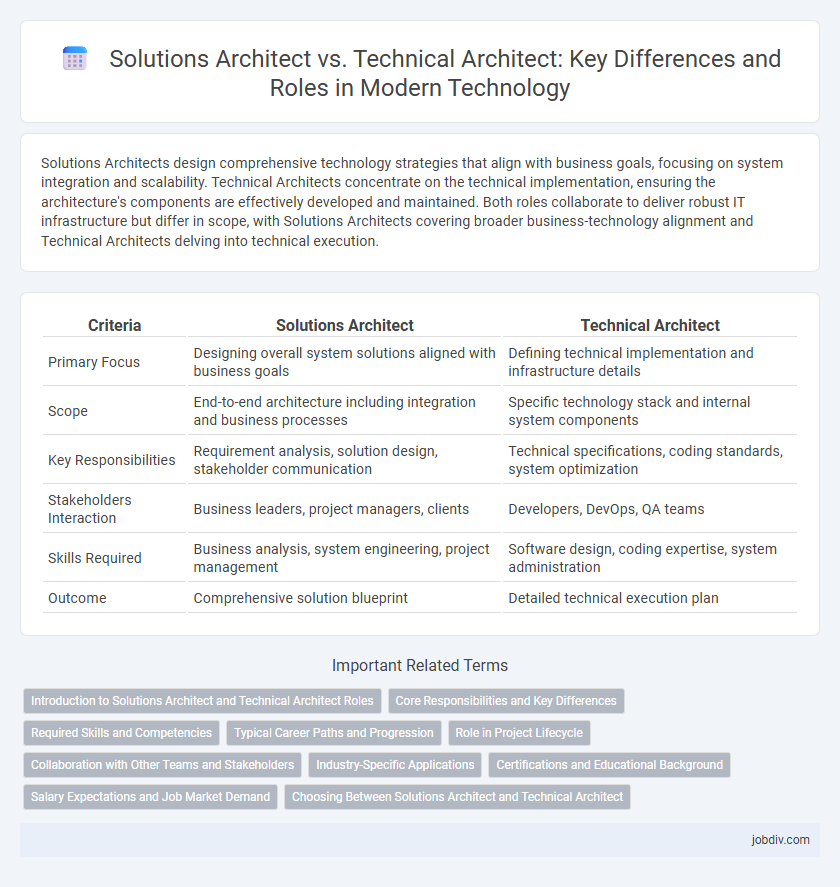Solutions Architects design comprehensive technology strategies that align with business goals, focusing on system integration and scalability. Technical Architects concentrate on the technical implementation, ensuring the architecture's components are effectively developed and maintained. Both roles collaborate to deliver robust IT infrastructure but differ in scope, with Solutions Architects covering broader business-technology alignment and Technical Architects delving into technical execution.
Table of Comparison
| Criteria | Solutions Architect | Technical Architect |
|---|---|---|
| Primary Focus | Designing overall system solutions aligned with business goals | Defining technical implementation and infrastructure details |
| Scope | End-to-end architecture including integration and business processes | Specific technology stack and internal system components |
| Key Responsibilities | Requirement analysis, solution design, stakeholder communication | Technical specifications, coding standards, system optimization |
| Stakeholders Interaction | Business leaders, project managers, clients | Developers, DevOps, QA teams |
| Skills Required | Business analysis, system engineering, project management | Software design, coding expertise, system administration |
| Outcome | Comprehensive solution blueprint | Detailed technical execution plan |
Introduction to Solutions Architect and Technical Architect Roles
Solutions Architects design comprehensive technology strategies that align business goals with IT infrastructure, ensuring scalable and efficient systems. Technical Architects focus on the detailed implementation and technical specifications, translating high-level solutions into workable technical frameworks. Both roles are critical in bridging the gap between business needs and technology execution within software development and IT projects.
Core Responsibilities and Key Differences
Solutions Architects focus on designing comprehensive IT solutions that align with business goals, integrating various systems and technologies to ensure scalability and efficiency. Technical Architects concentrate on the detailed implementation aspects, defining technical standards, coding practices, and infrastructure requirements to support the solution architecture. The key difference lies in Solutions Architects addressing broader business needs and solution integration, while Technical Architects specialize in the technical execution and architectural consistency within projects.
Required Skills and Competencies
Solutions Architects must demonstrate proficiency in system design, cloud computing platforms like AWS or Azure, and strong stakeholder communication to align IT solutions with business goals. Technical Architects require in-depth expertise in software development, infrastructure management, and technical problem-solving to ensure robust architecture and seamless integration of technology components. Both roles demand advanced knowledge of programming languages, network protocols, and an understanding of security best practices.
Typical Career Paths and Progression
Solutions Architects often start as software developers or business analysts, progressing by gaining expertise in system design, cloud platforms, and stakeholder communication, eventually moving into roles like enterprise architect or CTO. Technical Architects typically begin as software engineers or network specialists, advancing through mastering deep technical skills, infrastructure, and platform optimization, and may evolve into senior engineering management or chief technology officer positions. Both career paths emphasize continuous learning and leadership but differ in focus areas--Solutions Architects prioritize aligning technology with business needs, while Technical Architects concentrate on technical implementation and architecture integrity.
Role in Project Lifecycle
A Solutions Architect defines the overall IT strategy and system architecture during the initial project phases to ensure alignment with business goals and technical requirements. The Technical Architect focuses on the detailed design and implementation aspects, translating the high-level solution into specific technical components during development and deployment stages. Both roles collaborate closely to maintain coherence between conceptual frameworks and practical execution throughout the project lifecycle.
Collaboration with Other Teams and Stakeholders
Solutions Architects design comprehensive systems that integrate business needs with technology, facilitating effective collaboration with product managers, developers, and business analysts to ensure alignment on project goals and requirements. Technical Architects focus on the detailed implementation and infrastructure, working closely with development teams, IT operations, and security specialists to address technical challenges and maintain system integrity. Both roles prioritize stakeholder communication and cross-functional teamwork to deliver robust and scalable technology solutions.
Industry-Specific Applications
Solutions Architects design comprehensive technology frameworks tailored to industry-specific applications, ensuring integration of business goals with scalable IT solutions. Technical Architects focus on the detailed implementation and optimization of technology components within these frameworks, addressing technical challenges unique to sectors such as finance, healthcare, or manufacturing. Industry-specific knowledge enables Solutions Architects to align architecture with regulatory standards, while Technical Architects ensure robust performance and compliance at the system level.
Certifications and Educational Background
Solutions Architects typically hold certifications like AWS Certified Solutions Architect, Microsoft Certified: Azure Solutions Architect Expert, or TOGAF, emphasizing cloud platforms and enterprise architecture frameworks. Technical Architects often possess vendor-specific certifications such as Cisco Certified Network Professional (CCNP), Red Hat Certified Engineer (RHCE), or Microsoft Certified: Azure Administrator Associate, focusing on infrastructure, networking, and system integration. Educational backgrounds for both roles commonly include degrees in computer science, information technology, or engineering, with Solutions Architects leaning towards business and system design studies, while Technical Architects emphasize technical depth in hardware and software engineering.
Salary Expectations and Job Market Demand
Solutions Architects typically command higher salary expectations due to their broader scope in aligning business strategy with technology implementation, often earning between $110,000 and $160,000 annually in the U.S. Technical Architects, with specialized expertise in system design and infrastructure, usually have salaries ranging from $100,000 to $140,000 but remain in strong demand for their deep technical skills. The job market shows growing demand for Solutions Architects in enterprise digital transformation projects, while Technical Architects are essential for maintaining and upgrading complex IT environments.
Choosing Between Solutions Architect and Technical Architect
Choosing between a Solutions Architect and a Technical Architect depends on project scope and organizational goals, as Solutions Architects focus on aligning technology solutions with business needs while Technical Architects emphasize system design and implementation details. Solutions Architects manage cross-functional collaboration and ensure scalability, security, and integration across multiple platforms. Technical Architects specialize in technical frameworks, infrastructure, and software development best practices to deliver robust and maintainable systems.
Solutions Architect vs Technical Architect Infographic

 jobdiv.com
jobdiv.com